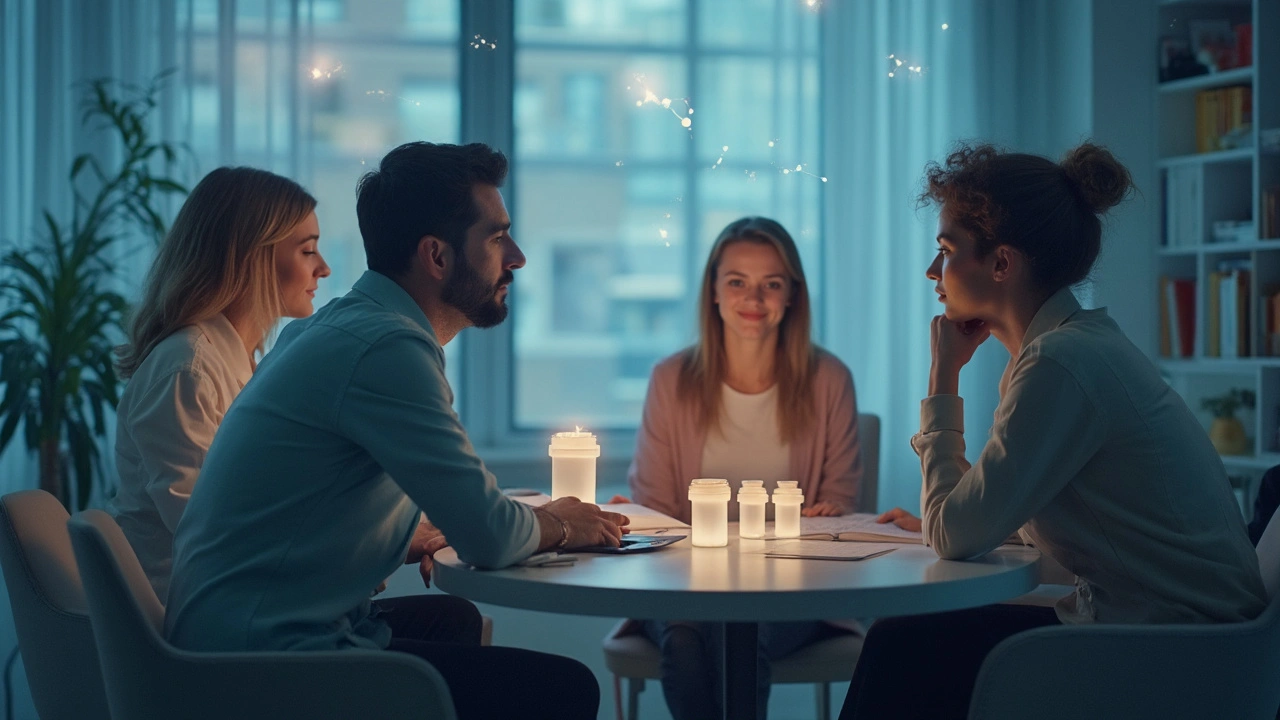Low-Dose Naltrexone: The New Frontier for Chronic Pain Relief

May, 21 2025
What if the answer to stubborn, relentless pain wasn’t a heavy-duty opioid or a steroid, but a tiny dose of a decades-old drug that’s been hiding in plain sight? For thousands living with chronic pain—think fibromyalgia, rheumatoid arthritis, neuropathy, and dozens more—low-dose naltrexone (LDN) might just be that hidden gem. LDN is gathering a surprising amount of buzz, not in some far-off medical future, but right here, right now. And people are paying close attention because it promises pain relief without the side effects of more notorious treatments like corticosteroids or opioids.
Understanding Low-Dose Naltrexone: What Is It and How Is It Used?
Naltrexone itself isn’t new. The drug’s been prescribed since the 1980s, mostly for those wanting to break free from opioid or alcohol addiction. The twist here is the dose—just a sliver of the amount usually given. Standard doses hover around 50mg; with LDN, we’re talking 1 to 4.5mg, a fraction of the original, repurposed for an entirely different mission. This tiny dose isn’t aimed at blocking street drugs; instead, it subtly re-trains how the body responds to pain and inflammation.
Doctors first stumbled onto LDN’s unexpected benefits thanks to a handful of brave patients and curious researchers. Back in the early 2000s, Dr. Bernard Bihari in New York noticed remarkable improvements in patients with autoimmune diseases who tried off-label naltrexone. Since then, clinics in Australia, the UK, North America, and beyond have quietly started writing LDN scripts, often for people who’ve cycled through the usual plan of anti-inflammatories, steroids, nerve drugs, and just want something gentler. And if you think this is all anecdote, hold on—the science is stacking up, too.
Here in Adelaide, a few GPs are catching on, but much of the movement comes from grassroots patient communities: online forums, social media groups, and support networks sharing personal experiences. Many feel they have nothing left to lose, after years of tough diagnoses and treatments with side effects worse than the original symptoms. That energy has fueled a wave of small pilot studies and larger clinical trials, turning naltrexone’s story into something much bigger than its old ‘addiction med’ label could ever cover.
The Science of LDN: How Does it Work for Chronic Pain?
So what’s really going on in the body when you take low-dose naltrexone? Instead of slamming the brakes on the brain’s opioid receptors (as in addiction treatment), a tiny nudge from LDN does something much subtler and, it turns out, very interesting for chronic pain. The best evidence points towards its action as an immunomodulator—it gently tweaks how the immune system operates, rather than shutting anything down completely.
LDN blocks the body’s opioid receptors for a few short hours overnight. This blockade fools the body into bouncing back the next morning with an upsurge in natural painkillers—endorphins and enkephalins. Those aren’t just ‘feel good’ chemicals; they help regulate pain, inflammation, and immune activity throughout the body. One study out of Stanford found that LDN, used nightly, led to a lasting drop in pain scores for people with fibromyalgia. Another small trial in Norway found similar results for multiple sclerosis. Scientists also suspect that LDN dampens microglial cells—inflammatory cells in the nervous system that play a bigger role in pain than most people realize.
The beauty is in the gentleness. Unlike steroids, which can ramp up blood sugar, mess with mood, or weaken bones if you use them too long, LDN slips in quietly. It doesn’t depress breathing like opioids, it doesn’t fry the liver like some long-term NSAIDs, and it’s not addictive. The negative side effects are minor for most—maybe a weird dream, mild insomnia the first week, or a bit of stomach discomfort. For many, it’s a risk worth taking compared to the spiral of steroid side effects or opioid dependence.
Here’s a quick snapshot of LDN’s main benefits, compared to traditional pain medications:
| Drug | Main Mechanism | Key Side Effects | Common Uses |
|---|---|---|---|
| Low-Dose Naltrexone | Boosts endorphins, modulates immune system | Mild insomnia, vivid dreams | Chronic pain, fibromyalgia, autoimmune disease |
| Prednisone (steroid) | Suppresses immune response, reduces inflammation | Weight gain, mood swings, diabetes risk, osteoporosis | Autoimmune flare-ups, severe inflammation |
| Opioids | Blocks pain signaling in nervous system | Dependence, constipation, sedation | Severe acute pain, cancer pain |

Who Is Trying Low-Dose Naltrexone: Real Data and Patient Stories
The best part about LDN is how it’s drawing in folks who normally wouldn’t have much in common. Rheumatologists, neurologists, GPs, and even pain specialists are cautiously exploring it for one reason: their patients keep asking. It’s not just the research, either. It’s the sheer size of the anecdotal wave, every story beginning with that classic Aussie understatement: “I thought I’d give it a go, see what happens.”
In a 2022 Australian survey of over 700 chronic pain patients, nearly half said they’d at least heard of LDN, and about 20% reported using it either now or in the past. When researchers tracked these users, they noticed two things: Pain scores dropped meaningfully for about two-thirds of people, and the side effect rate was noticeably less than other favorite pain meds. We’re not talking miracle cures, but the numbers are hard to ignore. Another Stanford study tracked 31 patients with fibromyalgia and found that over 30% achieved what researchers defined as “significant, sustained pain relief”—with minimal side effects. Not many drugs (especially the older, repurposed ones) can boast that.
But who are they? A lot of users fall into the middle-aged bracket, mostly women, often diagnosed with autoimmune diseases whose symptoms don’t read like a textbook. You’ll hear stories from people with lupus, psoriasis, MS, Crohn’s, IBS, and conditions that medicine sometimes shrugs off with “idiopathic.” For many, LDN sits on top of a pile of previous treatments, from anti-inflammatories to heavy steroids, and it’s often described as the first thing to “take the edge off” in years. There’s always a range—some swear by it, some notice nothing, but the growing patient voice is pushing doctors to pay attention.
One thing to watch: LDN often needs time to show its impact—think weeks, not days. Some people report an initial uptick in symptoms (like fatigue or sleep changes) before things settle and, hopefully, improve. Patient support groups are key, too, sharing tips like when to take LDN for best results, or how to have a productive conversation with your GP. Others swap stories about pharmacies willing to compound the small doses, since you can’t buy low-dose tablets straight off the shelf in most countries yet, including Australia.
And the excitement doesn’t just stop at individual stories. There’s a growing pile of interest around alternatives to Prednisone for pain, especially for people who can't tolerate steroids or want to avoid their long-term risks. You can check out a roundup of scientifically-backed options at this resource: alternatives to Prednisone for pain.
Benefits and Limitations: The Honest Take on LDN
With all the hype comes the hard reality—LDN isn’t a one-size-fits-all miracle. Some people see huge improvements, others notice nothing at all. That’s partly down to how mysterious chronic pain is—two people with the same diagnosis can have wildly different experiences. But let’s look at what we really know.
First, the upsides: LDN’s side effect profile is shockingly mild. In clinical studies, less than 5% of people dropped out due to adverse effects. The most common issues (mild insomnia, vivid dreams, short-term headaches) usually peter out after a week or so. There are no reports of dependence or withdrawal, unlike with opioids or benzodiazepines. For those with liver issues or on multiple meds, LDN’s metabolism is also kind on the body. Plus, the immunomodulatory effect—tuning, not suppressing, the immune system—seems to sidestep most of the infection risk you’d see with long-term steroids or immunosuppressants.
But here’s where it gets tricky. Not everyone feels better. Studies point to about 30-60% of users seeing improvement, which still leaves a big chunk who don’t. There’s debate about why—maybe body chemistry, maybe the type of pain, maybe even the timing of dosing. Some clinicians suspect it works best for people with overactive immune systems (autoimmunity, fibromyalgia, MS) rather than classic injury-related pain. The lack of large-scale randomized controlled trials also leaves a few question marks, especially on the ideal dose, best timing, and who stands to benefit most.
Another hitch is access. Because the drug isn’t officially approved for chronic pain, doctors have to prescribe it ‘off-label.’ That can be a sticking point for some, especially if your GP isn’t up-to-date on the latest pain research. Pharmacists often need to compound the low doses themselves, which can mean higher costs or longer waits. And there’s still a touch of skepticism in the medical world—change is slow, especially when an old addiction drug starts popping up as a pain solution.
Check out this quick rundown of LDN’s most talked-about pros and cons:
- Pros: Minimal side effects, non-addictive, helps some people with hard-to-treat conditions, gentle immunomodulation, cheap compared to newer biologics.
- Cons: Not everyone responds, some docs are reluctant to prescribe, can be tough to source, lack of huge clinical trials for every diagnosis, insurance doesn't always cover it.

Getting Started With LDN: How to Talk to Your Doctor and Set Expectations
If LDN sounds like a fit, the first conversation starts with your doctor. Make sure you bring up your pain history, what you’ve tried before, and any sensitivities to other meds. Don’t be surprised if your GP isn’t familiar—LDN’s still not a standard feature in most medical textbooks. Showing up with a few studies (Stanford, the Norwegian MS trial, patient reports) helps, as does pointing out its off-label use in reputable clinics. Be honest about your goals—maybe it’s pain relief, maybe fewer flares, or better sleep.
Dosing typically starts low—about 1mg nightly, slowly moving up to a maximum of 4.5mg, based on how your body feels. Some people take it in the morning, but most get better results at bedtime, thanks to the way the body resets its endorphins overnight. Persistence pays off: improvement often emerges after 4-12 weeks, not right away. Many say it’s more about gradual, steady changes (less pain, sharper mental clarity, fewer bad days) than a dramatic overnight fix. You might be less achy after a walk, need less ibuprofen, or notice you’re less wiped out by everyday stuff.
Don’t skip monitoring. Check in with your doctor about potential side effects or interactions (especially if you’re on painkillers or immunosuppressants). Some docs request the occasional liver function test, just to be careful. And keep a symptom journal—it sounds nerdy, but it’ll help you spot real patterns, not just wishful thinking.
For those worried about the pharmacy puzzle, here’s the scoop: Ask your pharmacist to compound the dose, as normal tablets are way too strong. Most major city chemists can do this with a doctor’s script, but it might take a few days. Patients in rural areas sometimes order online from accredited pharmacies. Expect to pay about $60-90 for a month’s supply, depending on compounding fees. Health funds rarely cover off-label medications, so plan for out-of-pocket costs up front. Patient groups online are a goldmine for tips on finding good compounding chemists, sharing deals, and supporting each other with honest feedback as you go.
LDN’s story isn’t just about the drug—it’s a window into how pain treatment is shifting away from “bigger hammer” drugs to subtle options that empower the body’s own healing systems. Whether you’re taking it for rheumatoid pain, post-surgical nerve issues, or just exploring alternatives to more intense meds, the real message is hope mixed with honesty. No snake oil here—just a cautious new option, turning a few heads, and quietly changing lives one small dose at a time.
